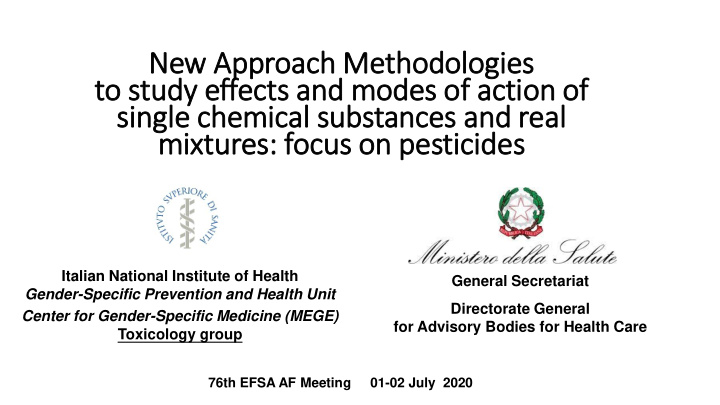



New Approach Methodologies to study effects and modes of f action of f single chemical substances and real mixt xtures: focus on pesticides Italian National Institute of Health General Secretariat Gender-Specific Prevention and Health Unit Directorate General Center for Gender-Specific Medicine (MEGE) for Advisory Bodies for Health Care Toxicology group 76th EFSA AF Meeting 01-02 July 2020
NEW APPROACH METHODOLOGIES: OUR WORKFLOW Human relevant In vitro cell models Battery of assays Omics AOP exposure concentrations • HBM studies • Cell lines • Cytotoxicity • Epigenomics • AOP-Wiki, already • Literature review • Primary cells • Apoptosis/Necrosis • Transcriptomics available • Development of a • Dietary intake • ROS • Proteomics new AOP • Agricultural use • 2D/3D • Mitochondrial Membrane • Bioinformatics Potential analysis (functional analysis, inference • Gene Expression of possible interacting entities, • Protein Expression network analysis) • Functional assays • Identification of new biomarkers
CURRENT FUNDED PROJECTS Coordinator: ISS-MEGE. «Integrated approach to evaluate children agricultural pesticide exposure and health outcome» Funded by Ministry of Health (RF-2016-02364628; 16/11/2018 - 15/11/2021). chlorpyrifos imidacloprid glyphosate single or in mixture Literature search for children exposure data Range of concentrations: 100 pM – 1 uM 2D Human mammary MCF7 MCF12A 48h 72h gland cells 3D Cytotoxicity Gene Hormone Epigenomic assays Expression secretion profiling In collaboration with Joell Ruegg from proliferation vitality ER α , ER β , AR, AhR, PR 17 β -estradiol Uppsala University
CURRENT FUNDED PROJECTS Coordinator: ISS-MEGE. «In vitro study on potential toxicological effects of active principles and their mixtures used against Peronospora and Oidio.» Funded by Consorzio Vini del Trentino (15/01/2018 – 14/01/2021). Compound/ 1 2 3 4 6 7=18 8=19 9 10=21 12 13 14 15 16 20 Mixtures Wet sulfur Potassium phosphonate Metrafenone Zoxamide Cyflufenamid Quinoxyfen Mancozeb Folpet Penconazol Dimethomorf
CURRENT FUNDED PROJECTS Coordinator: ISS-MEGE. «In vitro study on potential toxicological effects of active principles and their mixtures used against Peronospora and Oidio.» Funded by Consorzio Vini del Trentino (15/01/2018 – 14/01/2021). 15 Mixtures Really used concentrations on grapevines (1X) Relative toxicological Ten fold dilutions (1 to 10 6 ) ranking by the ToxPi Different modes of Human liver and lung action in the two HepG2 A549 cell lines cell lines 24h Collection of the ROS Cytotoxicity Gene overall data Mitochondrial Membrane Potential assays expression Apoptosis/Necrosis (IC10, IC20, IC50, Fold change, etc…) proliferation vitality BAX, BCL-2 NRF2, CYP1A1
Polybrominated diphenyl ethers SOME EXAMPLES Transcriptomics Proteomics Functional analysis In collaboration with the Core Facility at ISS Casella et al (manuscript in preparation) Tait et al (2017) Food Chem Toxicol
Bisphenol A effects on SOME EXAMPLES placenta angiogenesis Systematic review Ad hoc in vitro test development HUVEC primary cells + Human trophoblasts cell line (BeWo) to increase the weight of evidence of Key Events Relationships (KERs) In collaboration with the Department of Environment and Health at ISS Tait et al (2015) J Appl Toxicol Members of the EAGMST working group at OECD
CONCLUSIONS • The use of in vitro models to study effects of environmentally/dietary relevant exposure concentrations of chemical compounds allows the identification of subtle and precocious effects which may be harmful for human health • The use of omics and bioinformatics methods allows the identification of modes of action of chemical substances, also at environmentally/dietary relevant exposure concentrations • The shift toward the use of primary cells, 3D, organoids, organ-on-chip models will allow to study more complex scenario and cross-talks between different cell type for a better definition of adverse effects and modes of action. Particular attention should be given to the use of vitro models considering the two sexes (e.g. primary male and female cells from the same organ) since different effects and modes of action may occur • The availability of a growing number of AOPs will help to fill the knowledge gaps due to fragmented data obtained with different methods, by different groups, gathering all the information in one place. Once an AOP is defined, new methods may be developed for the quantitative weight of evidence of each Key Event/Key Events Relationships.
THANK YOU FOR YOUR ATTENTION!
Recommend
More recommend